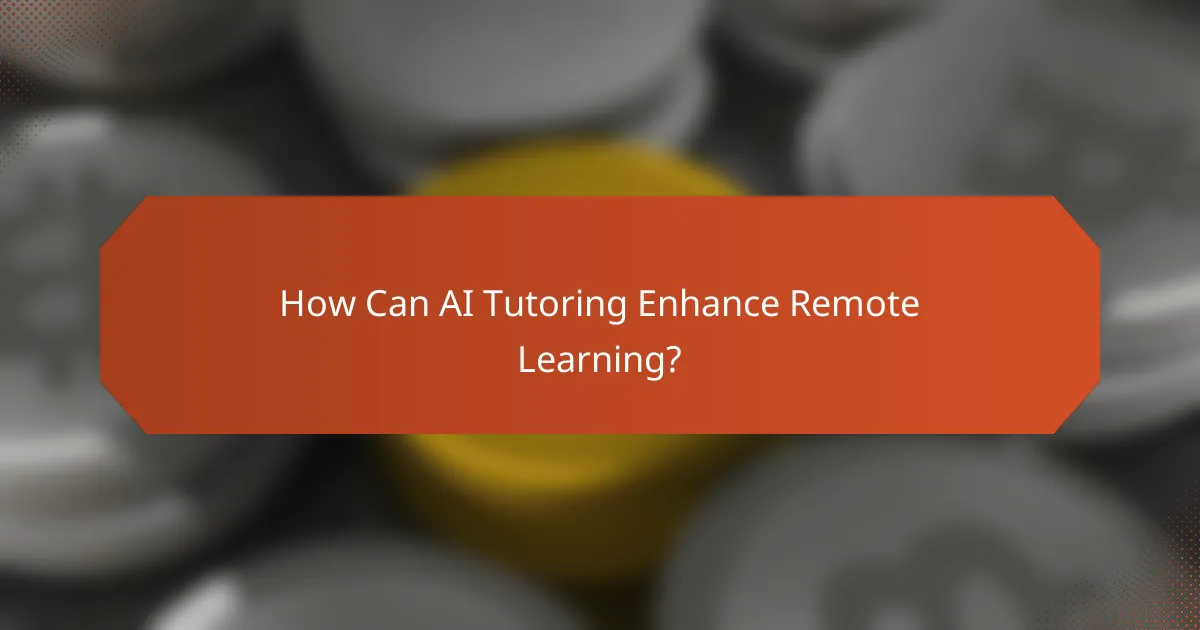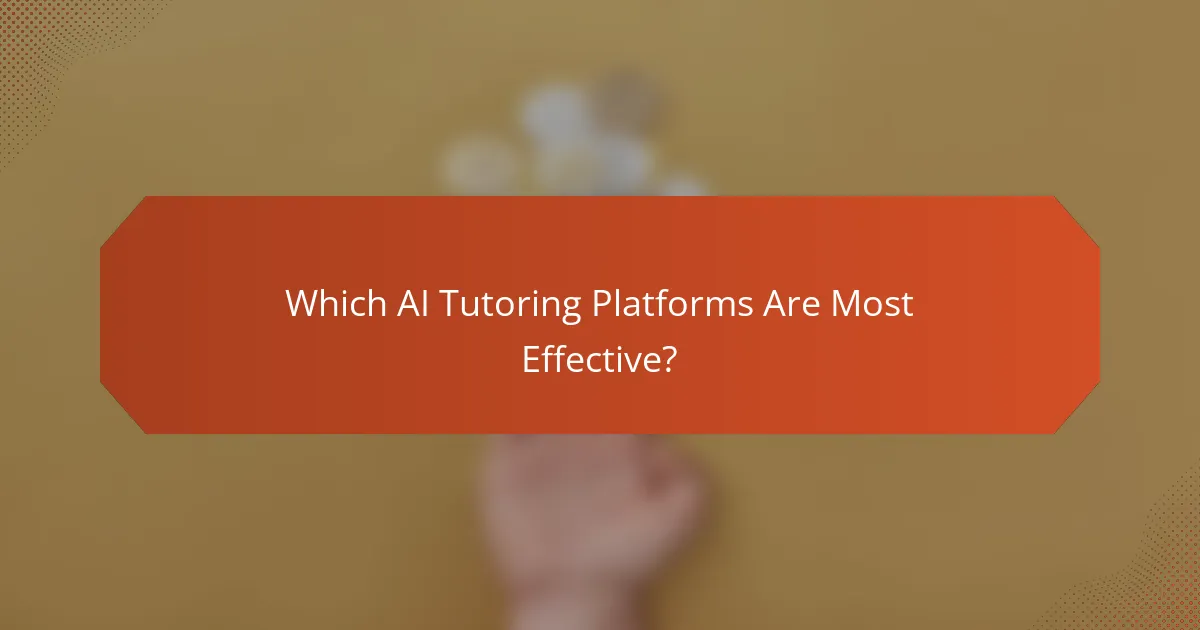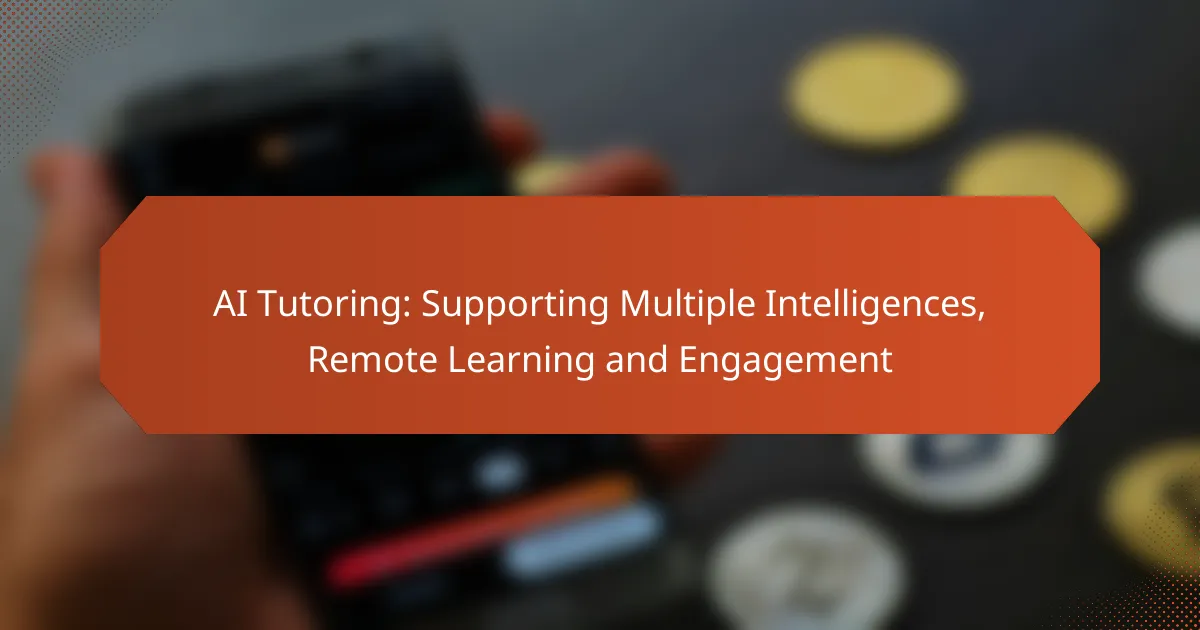AI tutoring is revolutionizing remote learning by providing personalized educational experiences that cater to individual student needs. By supporting multiple intelligences, these platforms create inclusive environments that enhance engagement and accessibility, allowing learners to interact with material in ways that align with their unique strengths.

How Can AI Tutoring Enhance Remote Learning?
AI tutoring enhances remote learning by providing tailored educational experiences that adapt to individual student needs. It leverages technology to facilitate engagement, accessibility, and immediate feedback, making learning more effective and enjoyable.
Personalized learning experiences
AI tutoring systems analyze student performance and learning styles to create customized lesson plans. This personalization allows students to progress at their own pace, focusing on areas where they need improvement while reinforcing their strengths.
For example, an AI tutor might adjust the difficulty of math problems based on a student’s previous answers, ensuring that they are neither too easy nor too challenging. This approach can lead to better retention and understanding of the material.
Real-time feedback and assessment
AI tutoring provides instant feedback, allowing students to understand their mistakes immediately. This real-time assessment helps learners correct errors and grasp concepts more effectively, promoting a deeper understanding of the subject matter.
For instance, if a student struggles with a particular grammar rule in language learning, the AI can highlight the error and offer explanations or additional practice exercises right away, facilitating a more dynamic learning process.
Flexible scheduling and accessibility
AI tutoring offers flexibility that traditional learning environments often lack. Students can access tutoring sessions at any time, accommodating different schedules and learning preferences.
This accessibility is particularly beneficial for students in various time zones or those balancing other commitments, such as work or family. AI tutors can be available 24/7, providing support whenever it is needed.
Engagement through interactive tools
AI tutoring platforms often incorporate interactive tools that enhance student engagement. Features like gamified learning, quizzes, and simulations make the learning process more enjoyable and can motivate students to participate actively.
For example, a science tutoring program might use virtual labs to allow students to conduct experiments online, fostering curiosity and a hands-on approach to learning. Such interactive elements can significantly improve student retention and interest in the subject matter.

What Are the Benefits of Supporting Multiple Intelligences?
Supporting multiple intelligences in education enhances learning by catering to the diverse strengths and preferences of students. This approach fosters a more inclusive environment, allowing learners to engage with material in ways that resonate with their individual capabilities.
Tailored content for diverse learners
Tailoring content for diverse learners means adapting educational materials to fit various intelligence types, such as linguistic, logical-mathematical, or spatial. For instance, a lesson on geometry could include visual diagrams for spatial learners and word problems for linguistic learners. This customization helps ensure that all students can access and understand the material effectively.
Utilizing AI tutoring systems can facilitate this tailoring by analyzing student performance and preferences. These systems can then recommend resources or activities that align with each learner’s strengths, making education more personalized and effective.
Improved student motivation and engagement
When students encounter learning experiences that align with their intelligences, their motivation and engagement levels significantly increase. For example, a student with a strong musical intelligence may be more engaged in a lesson that incorporates rhythm and song. This connection can lead to a more positive attitude towards learning and a willingness to participate actively.
To further enhance engagement, educators can incorporate gamified elements or interactive activities that appeal to different intelligences. This approach not only makes learning enjoyable but also encourages students to take ownership of their educational journey.
Enhanced retention of knowledge
Supporting multiple intelligences can lead to better retention of knowledge, as students are more likely to remember information presented in a way that resonates with them. For instance, a student who learns through hands-on activities may retain concepts better when they can physically manipulate objects related to the lesson.
To maximize retention, educators should consider using a mix of teaching methods that cater to various intelligences. This can include visual aids, group discussions, and practical exercises, ensuring that students have multiple pathways to internalize the material. By doing so, learners are more likely to recall information long after the lesson is over.

Which AI Tutoring Platforms Are Most Effective?
Effective AI tutoring platforms leverage technology to adapt to diverse learning styles and enhance remote education. Key players include Khan Academy, Duolingo, Coursera, and Edmodo, each offering unique features to engage learners.
Khan Academy
Khan Academy provides a comprehensive learning experience through personalized learning dashboards that cater to individual student needs. It covers a wide range of subjects, from math to arts, and offers practice exercises and instructional videos.
The platform is particularly effective for self-paced learning, allowing students to progress through materials at their own speed. This flexibility can be beneficial for learners who need more time to grasp complex concepts.
Duolingo
Duolingo focuses on language learning through gamified lessons that engage users with interactive exercises. Its AI-driven approach tailors lessons based on user performance, making it suitable for learners at various proficiency levels.
The platform encourages daily practice with reminders and rewards, which can significantly enhance retention and motivation. Duolingo’s bite-sized lessons are ideal for busy individuals looking to learn a new language in short, manageable sessions.
Coursera
Coursera partners with universities and organizations to offer a wide array of courses, from computer science to business management. The platform utilizes AI to recommend courses based on user interests and previous learning experiences.
Students can access both free and paid courses, with the option to earn certificates that may enhance their professional credentials. This flexibility allows learners to choose paths that align with their career goals while accommodating their schedules.
Edmodo
Edmodo serves as a social learning platform that connects teachers, students, and parents. It facilitates communication and collaboration through discussion boards, assignments, and resource sharing, making it effective for remote learning environments.
The platform’s focus on community engagement helps foster a supportive learning atmosphere. Edmodo also offers tools for tracking student progress, which can assist educators in identifying areas where students may need additional support.

How Do AI Tutors Adapt to Different Learning Styles?
AI tutors adapt to various learning styles by utilizing tailored approaches that cater to individual preferences. These systems analyze user interactions and performance to deliver customized content that aligns with visual, auditory, or kinesthetic learning modalities.
Visual aids for visual learners
Visual learners benefit from AI tutors that incorporate images, diagrams, and videos to enhance understanding. These tools can simplify complex concepts by presenting information in a visually engaging manner.
For instance, an AI tutor might use infographics to summarize key points or interactive charts to illustrate data relationships. This approach helps visual learners grasp material more effectively and retain information longer.
Interactive simulations for kinesthetic learners
Kinesthetic learners thrive on hands-on experiences, and AI tutors can provide interactive simulations to facilitate this. These simulations allow learners to engage with content actively, experimenting and exploring concepts in a virtual environment.
For example, a science AI tutor might offer a virtual lab where students can conduct experiments. This method not only reinforces learning but also keeps students motivated and engaged in their studies.
Auditory resources for auditory learners
Auditory learners excel when information is presented through sound, and AI tutors can cater to this by offering podcasts, audio lessons, and verbal explanations. These resources help reinforce learning through listening and discussion.
AI tutors may also include features that allow students to listen to content while following along with text, enhancing comprehension. This dual approach can significantly improve retention for auditory learners, making the learning experience more effective.

What Criteria Should You Consider When Choosing an AI Tutor?
When selecting an AI tutor, consider factors like cost, subject range, and user experience. These elements significantly impact the effectiveness and accessibility of the tutoring service.
Cost and subscription models
Cost is a crucial factor when choosing an AI tutor, as prices can vary widely. Some platforms offer free basic services, while others may charge monthly subscriptions ranging from $10 to $50 or more, depending on features and content depth.
Evaluate whether the subscription model suits your needs. Some services provide pay-as-you-go options, which can be beneficial if you require tutoring intermittently. Always check for hidden fees or additional costs for premium features.
Range of subjects offered
The range of subjects available is essential for ensuring the AI tutor meets your educational needs. Many AI tutoring platforms cover core subjects like math, science, and language arts, while others may offer specialized topics such as coding or foreign languages.
Before committing, review the subject offerings to ensure they align with your learning goals. Some platforms may also provide personalized learning paths, which can enhance the tutoring experience by adapting to individual strengths and weaknesses.
User interface and experience
A user-friendly interface is vital for effective learning with an AI tutor. Look for platforms that offer intuitive navigation, clear instructions, and engaging content. A well-designed interface can significantly enhance the learning experience.
Consider trying out a demo or free trial to assess the user experience. Pay attention to how easily you can access resources, track progress, and interact with the AI. A positive user experience can lead to better engagement and retention of information.
